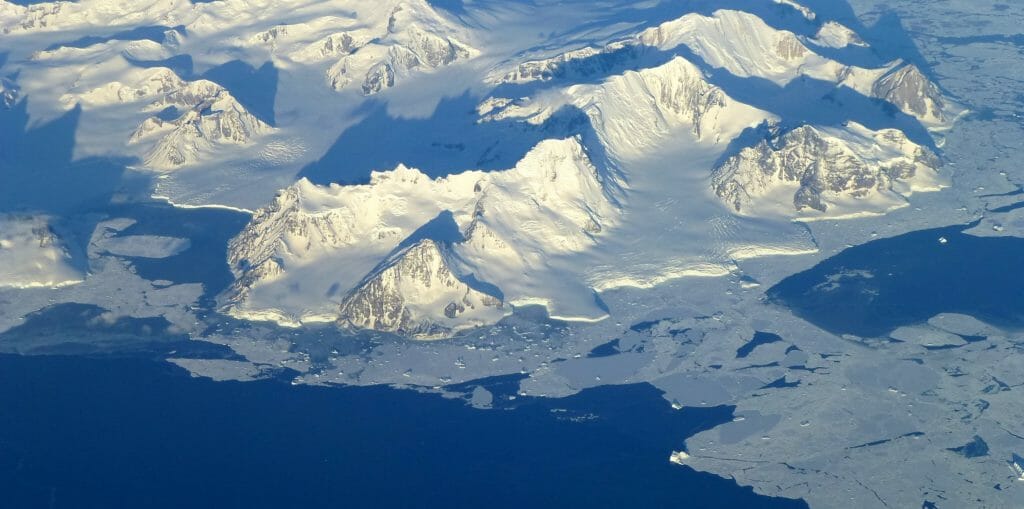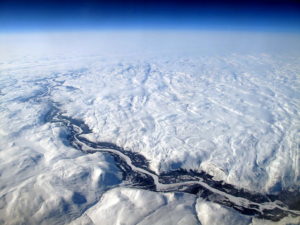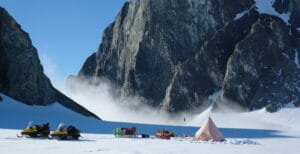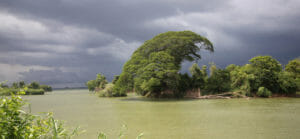Rising Rocks in West Antarctica May Slow Ice Melt
In a dramatic demonstration of geology’s in-depth response to surface change, the submerged bedrock of that part of the southern continent is springing up at a rate of nearly 2 inches a year. Mountains on the northern Antarctic Peninsula coast. (NASA/Maria-Jose Vinas)
Mountains on the northern Antarctic Peninsula coast. (NASA/Maria-Jose Vinas)
Its ice sheet may be melting, but West Antarctica’s rocks are on the way up. In a dramatic demonstration of geology’s in-depth response to surface change, the submerged bedrock of that part of the southern continent is springing upwards at 41mm [1.61 inches] a year.
And as it does so, it may slow the rate of inexorable ice melt, as the western part of the continent sheds ice in response to global warming driven by profligate human combustion of fossil fuels.
But for the moment the finding is yet another surprising demonstration of what geophysicists call isostatic response: as mass is shifted from the surface of the continent – and that region of Antarctica has lost three trillion metric tons of ice in the last 25 years – the semi-liquid rocks of the Earth’s mantle, deep below the continental crust, flow below the lightening burden to lift the crustal rocks higher.
This rate of rise is unexpectedly rapid. As more ice melts, the process is likely to accelerate. A century from now, that stretch of Antarctic peninsula could have risen by 8 metres [26.2 feet].
“When the ice melts and gets thinner, the Earth readjusts, and rises immediately by a few millimetres, which depends on the ice lost,” said Valentina Barletta, of the Technical University of Denmark, who led the research.
“But the earth also acts a bit like a very hard memory-foam mattress. And it slowly keeps readjusting for several thousand years after the melting. In Scandinavia the bedrock is still rising about 10 millimetres per year because of the last ice age.”
Dr Barletta and US colleagues report in the journal Science that they gathered data from six global positioning satellite stations fixed to the exposed rock around a stretch of West Antarctica called the Amundsen Sea embayment.
They coupled that with seismic studies of the crustal bedrock and then ran an immense number of computer simulations to settle on the most likely explanation – that deep beneath that point of the southern continent, the Earth’s mantle was relatively hotter and more fluid, and could respond to changes in mass more swiftly.
Polar Perplexities
At the heart of such research is the puzzle of southern polar dynamics: the complex interplay of ocean, atmosphere, precipitation and topography that keeps Antarctica the coldest, driest, iciest place on the planet: it may be technically a desert, but its continental crust carries almost two thirds of the world’s freshwater in frozen form. If it all melted, global sea levels would rise by 70 metres.
But such is the weight of ice that some parts of the continent are depressed below sea level. In West Antarctica the surrounding sea ice is so thick it is anchored to submerged bedrock, to provide a buffer that slows the rate of glacial flow from inland.
Right now, the West Antarctic Ice Sheet is spilling into the oceans the equivalent of a quarter of all the planet’s melting ice. If all of West Antarctica were to melt, global sea levels would rise by three metres.
And the fear is that, as the oceans and atmosphere warm in response to ever-rising levels of greenhouse gases in the atmosphere, winds and currents could loosen the great shelves of sea ice and send them floating north, at which point the glacial flow from the high ground of the continent to the sea would accelerate.
Stability Explained
So the latest discovery helps explain the wider puzzle of why Antarctica’s ice has been relatively stable over long geological periods: as the ice melts, the bedrock rises, and the ice shelves are more likely to stay anchored to the mainland, at least at that particular “pinning point” above a hotter, more fluid mantle.
There is another factor at work: the gravitational pull of the ice itself, which raises sea level near the great mass of ancient polar ice. As the ice melts, the gravitational tug diminishes, and the sea levels subside.
“The lowering of the sea level, the rising of the pinning points and the decrease of the inland slope due to the uplift of the bedrock are all feedbacks that can stabilise the ice sheet,” said Terry Wilson, of Ohio State University, and one of the authors. “Under many realistic climate models, this should be enough to stabilise the ice sheet.”
But as planetary average temperatures rise, so does the hazard. Rick Aster, of Colorado State University, and another of the authors, warned: “To keep global sea levels from rising more than a few feet this century and beyond, we must still limit greenhouse gas concentrations in the atmosphere, which can only occur through international cooperation and innovation.”
Your support is crucial…With an uncertain future and a new administration casting doubt on press freedoms, the danger is clear: The truth is at risk.
Now is the time to give. Your tax-deductible support allows us to dig deeper, delivering fearless investigative reporting and analysis that exposes what’s really happening — without compromise.
Stand with our courageous journalists. Donate today to protect a free press, uphold democracy and unearth untold stories.






You need to be a supporter to comment.
There are currently no responses to this article.
Be the first to respond.